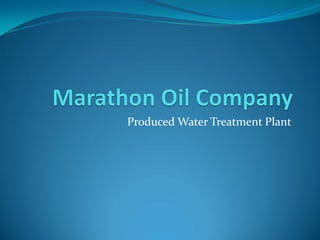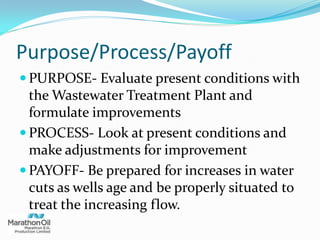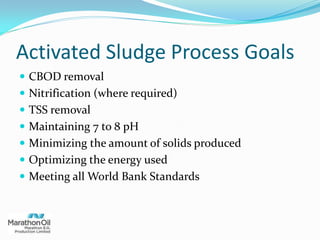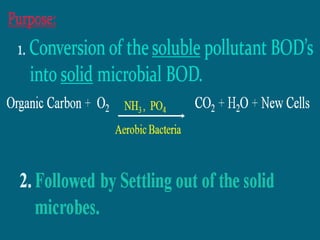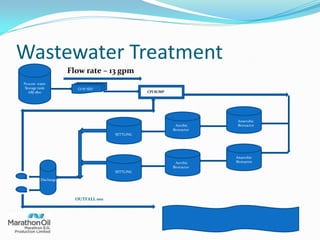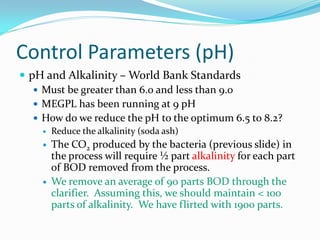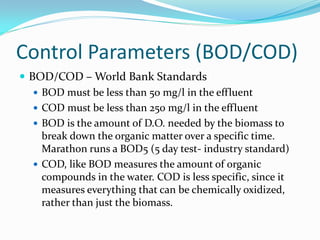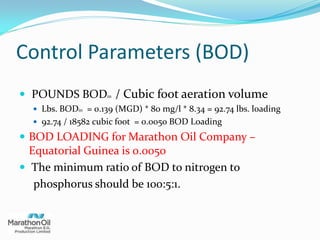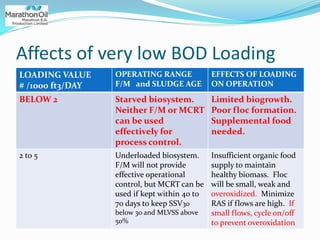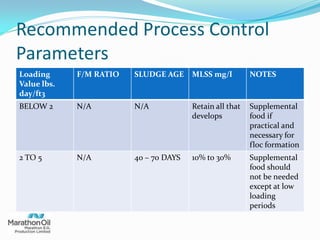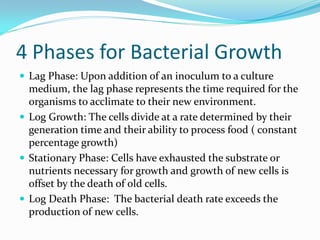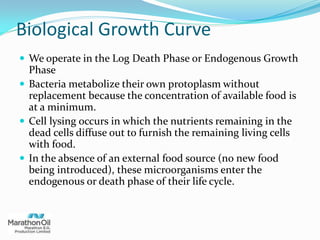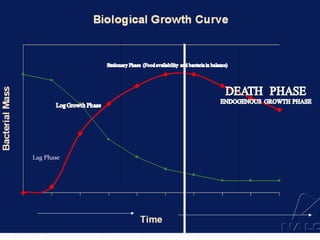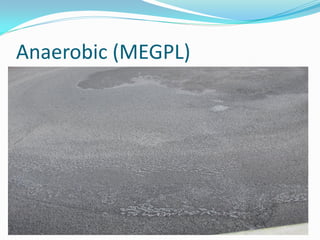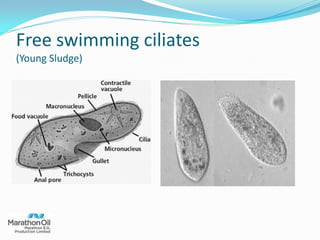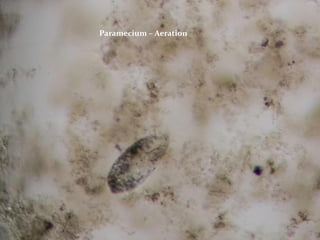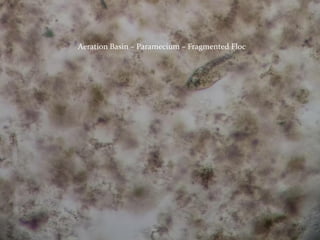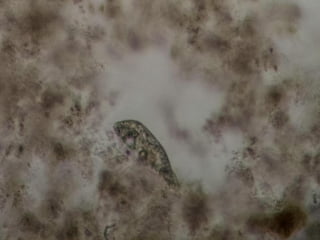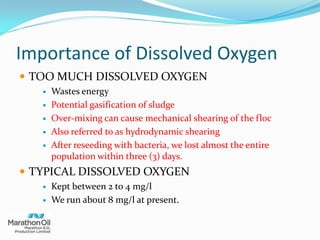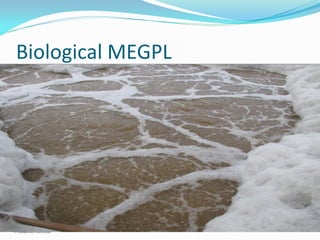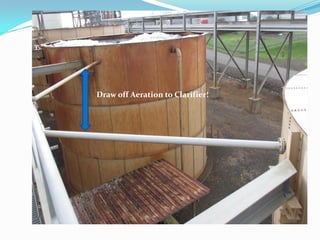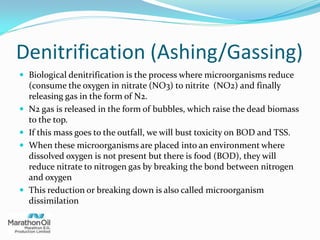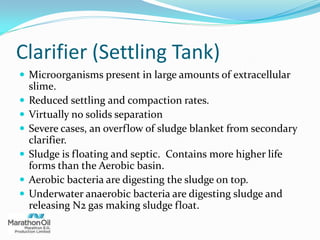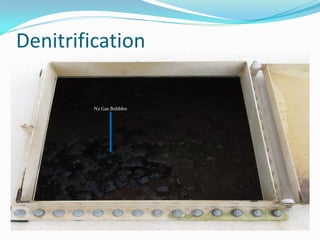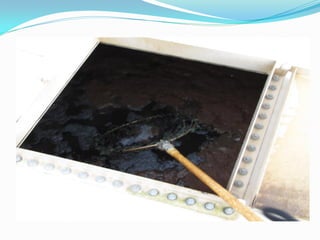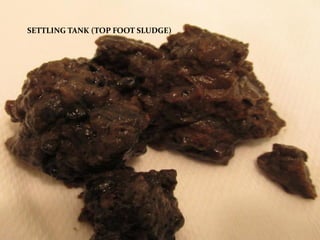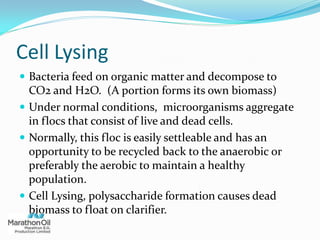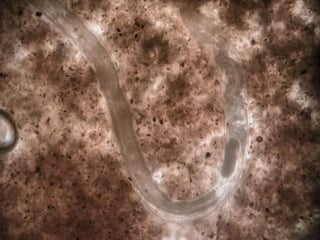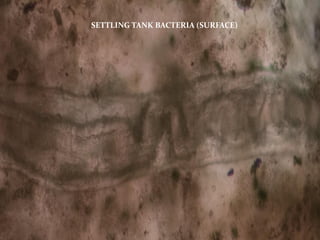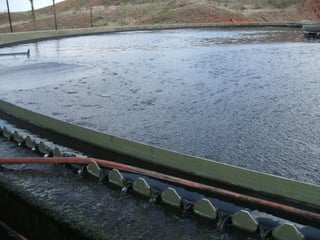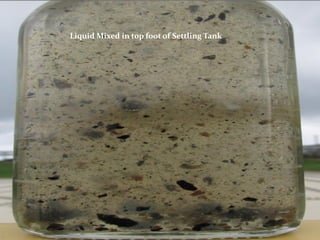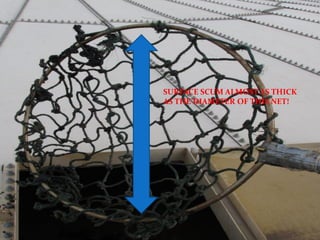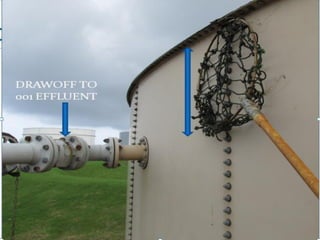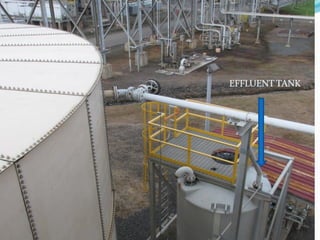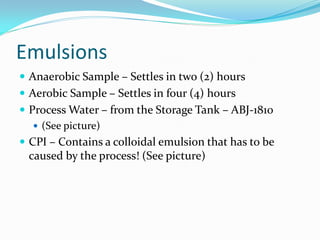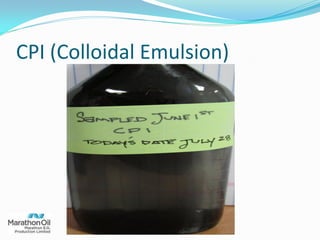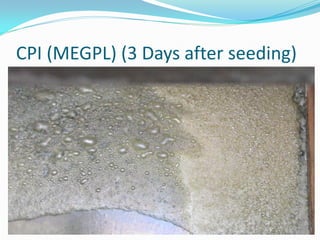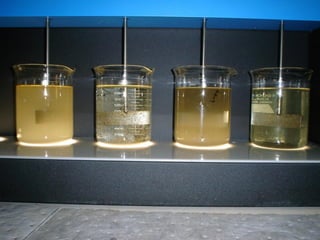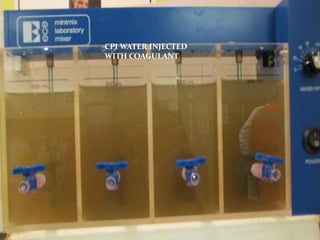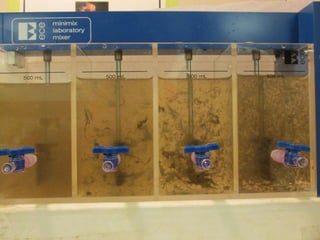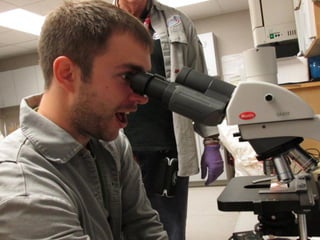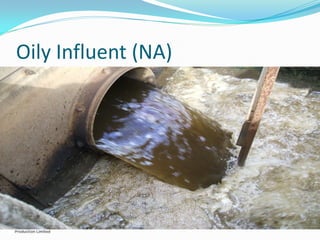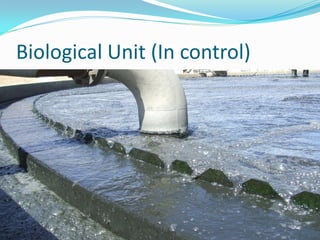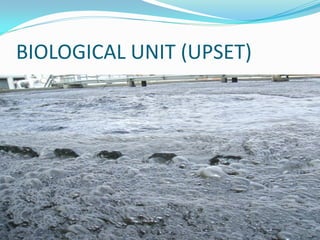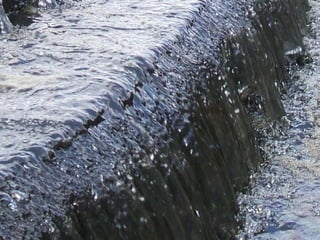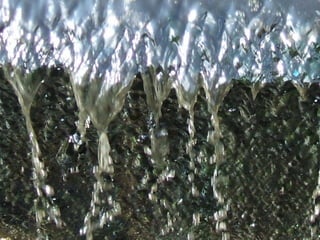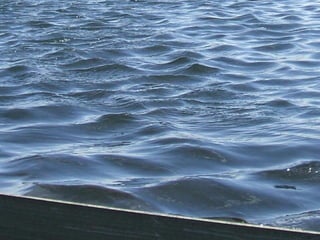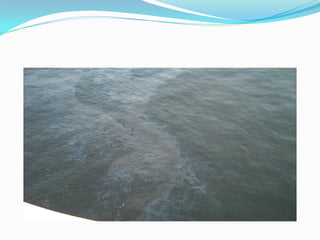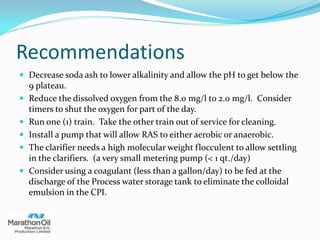MEGPL-PWTP Plant
- 1. Produced Water Treatment Plant
- 2. Purpose/Process/Payoff ÔÇó PURPOSE- Evaluate present conditions with the Wastewater Treatment Plant and formulate improvements ÔÇó PROCESS- Look at present conditions and make adjustments for improvement ÔÇó PAYOFF- Be prepared for increases in water cuts as wells age and be properly situated to treat the increasing flow.
- 3. Activated Sludge Process Goals ÔÇó CBOD removal ÔÇó Nitrification (where required) ÔÇó TSS removal ÔÇó Maintaining 7 to 8 pH ÔÇó Minimizing the amount of solids produced ÔÇó Optimizing the energy used ÔÇó Meeting all World Bank Standards
- 5. Wastewater Treatment Anaerobic BioreactorAerobic Bioreactor Aerobic Bioreactor Process water Storage tank ABJ-1810 O/W SEP. CPI SUMP Anaerobic Bioreactor SETTLING SETTLING Discharge OUTFALL 001 Flow rate – 13 gpm
- 6. Control Parameters (pH)  pH and Alkalinity – World Bank Standards  Must be greater than 6.0 and less than 9.0  MEGPL has been running at 9 pH  How do we reduce the pH to the optimum 6.5 to 8.2?  Reduce the alkalinity (soda ash)  The CO2 produced by the bacteria (previous slide) in the process will require ½ part alkalinity for each part of BOD removed from the process.  We remove an average of 90 parts BOD through the clarifier. Assuming this, we should maintain < 100 parts of alkalinity. We have flirted with 1900 parts.
- 7. Control Parameters (BOD/COD)  BOD/COD – World Bank Standards  BOD must be less than 50 mg/l in the effluent  COD must be less than 250 mg/l in the effluent  BOD is the amount of D.O. needed by the biomass to break down the organic matter over a specific time. Marathon runs a BOD5 (5 day test- industry standard)  COD, like BOD measures the amount of organic compounds in the water. COD is less specific, since it measures everything that can be chemically oxidized, rather than just the biomass.
- 8. Control Parameters (BOD)  POUNDS BODin / Cubic foot aeration volume  Lbs. BODin = 0.139 (MGD) * 80 mg/l * 8.34 = 92.74 lbs. loading  92.74 / 18582 cubic foot = 0.0050 BOD Loading  BOD LOADING for Marathon Oil Company – Equatorial Guinea is 0.0050  The minimum ratio of BOD to nitrogen to phosphorus should be 100:5:1.
- 9. Affects of very low BOD Loading LOADING VALUE # /1000 ft3/DAY OPERATING RANGE F/M and SLUDGE AGE EFFECTS OF LOADING ON OPERATION BELOW 2 Starved biosystem. Neither F/M or MCRT can be used effectively for process control. Limited biogrowth. Poor floc formation. Supplemental food needed. 2 to 5 Underloaded biosystem. F/M will not provide effective operational control, but MCRT can be used if kept within 40 to 70 days to keep SSV30 below 30 and MLVSS above 50% Insufficient organic food supply to maintain healthy biomass. Floc will be small, weak and overoxidized. Minimize RAS if flows are high. If small flows, cycle on/off to prevent overoxidation
- 10. Recommended Process Control Parameters Loading Value lbs. day/ft3 F/M RATIO SLUDGE AGE MLSS mg/l NOTES BELOW 2 N/A N/A Retain all that develops Supplemental food if practical and necessary for floc formation 2 TO 5 N/A 40 – 70 DAYS 10% to 30% Supplemental food should not be needed except at low loading periods
- 11. 4 Phases for Bacterial Growth ÔÇó Lag Phase: Upon addition of an inoculum to a culture medium, the lag phase represents the time required for the organisms to acclimate to their new environment. ÔÇó Log Growth: The cells divide at a rate determined by their generation time and their ability to process food ( constant percentage growth) ÔÇó Stationary Phase: Cells have exhausted the substrate or nutrients necessary for growth and growth of new cells is offset by the death of old cells. ÔÇó Log Death Phase: The bacterial death rate exceeds the production of new cells.
- 12. Biological Growth Curve ÔÇó We operate in the Log Death Phase or Endogenous Growth Phase ÔÇó Bacteria metabolize their own protoplasm without replacement because the concentration of available food is at a minimum. ÔÇó Cell lysing occurs in which the nutrients remaining in the dead cells diffuse out to furnish the remaining living cells with food. ÔÇó In the absence of an external food source (no new food being introduced), these microorganisms enter the endogenous or death phase of their life cycle.
- 13. Lag Phase
- 15. Free swimming ciliates (Young Sludge)
- 17. Aeration Basin – Paramecium – Fragmented Floc
- 19. Importance of Dissolved Oxygen ÔÇó TOO MUCH DISSOLVED OXYGEN ÔÇó Wastes energy ÔÇó Potential gasification of sludge ÔÇó Over-mixing can cause mechanical shearing of the floc ÔÇó Also referred to as hydrodynamic shearing ÔÇó After reseeding with bacteria, we lost almost the entire population within three (3) days. ÔÇó TYPICAL DISSOLVED OXYGEN ÔÇó Kept between 2 to 4 mg/l ÔÇó We run about 8 mg/l at present.
- 20. Biological MEGPL
- 21. Draw off Aeration to Clarifier!
- 22. Denitrification (Ashing/Gassing) ÔÇó Biological denitrification is the process where microorganisms reduce (consume the oxygen in nitrate (NO3) to nitrite (NO2) and finally releasing gas in the form of N2. ÔÇó N2 gas is released in the form of bubbles, which raise the dead biomass to the top. ÔÇó If this mass goes to the outfall, we will bust toxicity on BOD and TSS. ÔÇó When these microorganisms are placed into an environment where dissolved oxygen is not present but there is food (BOD), they will reduce nitrate to nitrogen gas by breaking the bond between nitrogen and oxygen ÔÇó This reduction or breaking down is also called microorganism dissimilation
- 23. Clarifier (Settling Tank) ÔÇó Microorganisms present in large amounts of extracellular slime. ÔÇó Reduced settling and compaction rates. ÔÇó Virtually no solids separation ÔÇó Severe cases, an overflow of sludge blanket from secondary clarifier. ÔÇó Sludge is floating and septic. Contains more higher life forms than the Aerobic basin. ÔÇó Aerobic bacteria are digesting the sludge on top. ÔÇó Underwater anaerobic bacteria are digesting sludge and releasing N2 gas making sludge float.
- 26. SETTLING TANK (TOP FOOT SLUDGE)
- 27. Cell Lysing ÔÇó Bacteria feed on organic matter and decompose to CO2 and H2O. (A portion forms its own biomass) ÔÇó Under normal conditions, microorganisms aggregate in flocs that consist of live and dead cells. ÔÇó Normally, this floc is easily settleable and has an opportunity to be recycled back to the anaerobic or preferably the aerobic to maintain a healthy population. ÔÇó Cell Lysing, polysaccharide formation causes dead biomass to float on clarifier.
- 29. SETTLING TANK BACTERIA (SURFACE)
- 31. Liquid Mixed in top foot of Settling Tank
- 32. SURFACE SCUM ALMOST AS THICK AS THE DIAMETER OF THIS NET!
- 34. EFFLUENT TANK
- 35. Emulsions  Anaerobic Sample – Settles in two (2) hours  Aerobic Sample – Settles in four (4) hours  Process Water – from the Storage Tank – ABJ-1810  (See picture)  CPI – Contains a colloidal emulsion that has to be caused by the process! (See picture)
- 37. CPI (MEGPL) (3 Days after seeding)
- 39. CPI WATER INJECTED WITH COAGULANT
- 43. Biological Unit (In control)
- 49. Recommendations ÔÇó Decrease soda ash to lower alkalinity and allow the pH to get below the 9 plateau. ÔÇó Reduce the dissolved oxygen from the 8.0 mg/l to 2.0 mg/l. Consider timers to shut the oxygen for part of the day. ÔÇó Run one (1) train. Take the other train out of service for cleaning. ÔÇó Install a pump that will allow RAS to either aerobic or anaerobic. ÔÇó The clarifier needs a high molecular weight flocculent to allow settling in the clarifiers. (a very small metering pump (< 1 qt./day) ÔÇó Consider using a coagulant (less than a gallon/day) to be fed at the discharge of the Process water storage tank to eliminate the colloidal emulsion in the CPI.
